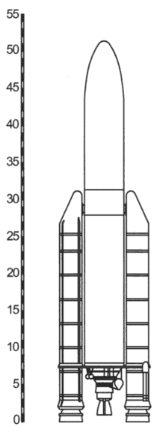Adapted from The Satellite Encyclopedia.
Ariane 5 launchers
The Ariane 5 program starting was decided by the ESA member states during the
conference of the Hague in November 1987, after a study begun in early 1985.
Built under the Aerospatiale leadership, Ariane 5 is completely different from
the Ariane which preceded in the architecture point of view. Its configuration
looks more like that of the American Titan, or even of the Shuttle, or of
Japanese H2. Like these launchers, Ariane 5 comprises a liquid propelled main
body and two large solid boosters.
The EAP (Etage d'Accélération … Poudre = Powder Acceleration Stage) is thus
composed of two MPS (Moteurs à Propulsion Solide = Solid Propulsion Motors) or
P 230, built by the Europropulsion group formed by SEP (France) and BPD (Italy).
Each MPS measures 27 m in length and 3 m in diameter and weighs 267 t with
237 t of propellant in three segments of PBHT (polybutadiene hydroxytelechelic).
They develop a 6 MN thrust at takeoff (ISp = 273 sec) and burn during 123 sec
before being jettisoned at 56 km of altitude.
The central body comprises a EPC (Etage Principal Cryotechnique = Cryogenic
Main Stage) and a EPS (Etage à Propergols Stockables = Storable Propellants
Stage). The EPC, which measures 30.5 m in length and 5.4 m in diameter, is
propelled by a SEP Vulcain derived flow engine. Its 880 kN thrust at sea
level reached 1130 kN in vacuum (ISP = 430 sec). The MPS are fired only after
control of the correct operation of the Vulcain engine, this one functions then
during 600 seconds, burning 131 t of LOX and 26 t of LH2. The EPS, alias L9,
carries 9.7 t of storable propellants (NTO and MMH-H) and ensure precise
positioning in orbit. It is equipped with a MBB-ERNO (now DASA) Aestus engine
with 28 kN thrust in vacuum, restartable and able to function up to 1150 seconds.
With the vehicle equipment bay and the fairing which exists in two versions,
Ariane 5 measures from 45.7 to 55.9 m height and weighs approximately 710 tons.
Its payload capacity in geostationary transfer orbit is 6.8 t for a simple
payload, 5.9 t for double payloads or 5.5 t for triple payloads.
The first test flight of June 1996 resulted in a failure due to a design
error in the guidance software, transposed without control from Ariane 4 to
Ariane 5. The second flight was a near success in October 1997 and the third
a total success in October 1998. The first commercial flight occurred in
December 1999.

Scale in meters
Ariane 5 launches
| Ar# | Launch id
| Payload | Launch Date | Type | Status/Comment |
|---|
| 88 | n/a
| CLUSTER | 04 Jun 1996 | 501 | Failure |
| 101 | 97066
| Mockups
µsats | 30 Oct 1997 | 502 | Transfert |
| 112 | 98059
| ARD
Maqsat 3 | 21 Oct 1998 | 503 | Re-entry
Transfert |
| 119 | 99066
| XMM | 10 Dec 1999 | 504 | 7415x113680x38.8 |
| 128 | 00016
| Asiastar
Insat 3B | 21 Mar 2000 | 505 | Geosynchronous |
| 130 | 00054
| Astra B | 14 Sep 2000 | 506 | Geosynchronous |
| 135 | 00072
| Panamsat 1R
µsats | 16 Nov 2000 | 507 | Geosynchronous
Transfert |
| 138 | 00081
| Astra 2D
GE 8/Aurora 3 | 20 Dec 2000 | 508 | Geosynchronous |
External Ressources
Arianespace, Launcher Family
Ariane 5
Please contact
Jean-Jacques Serra <JJ.Serra@wanadoo.fr> for comments, corrections or questions
